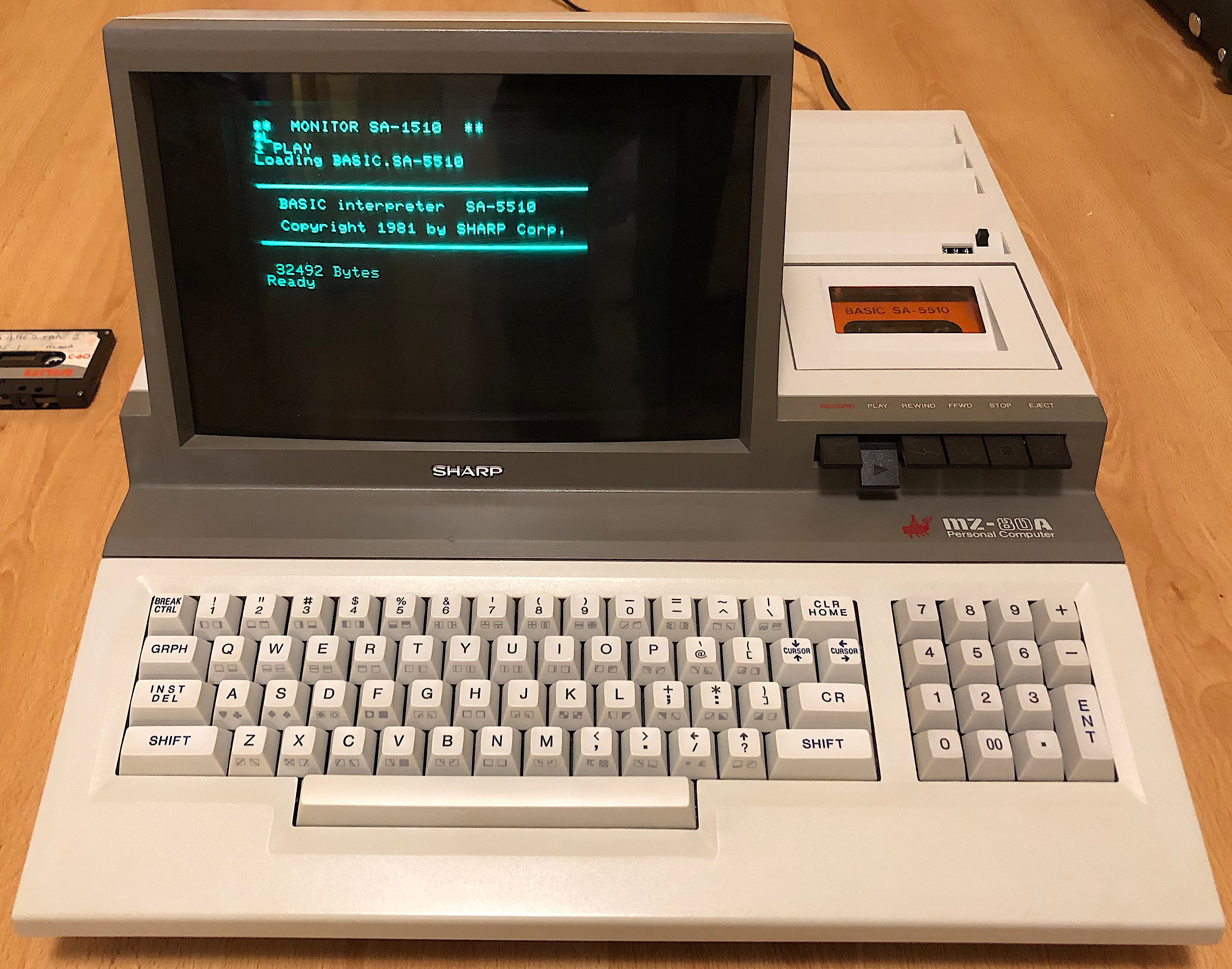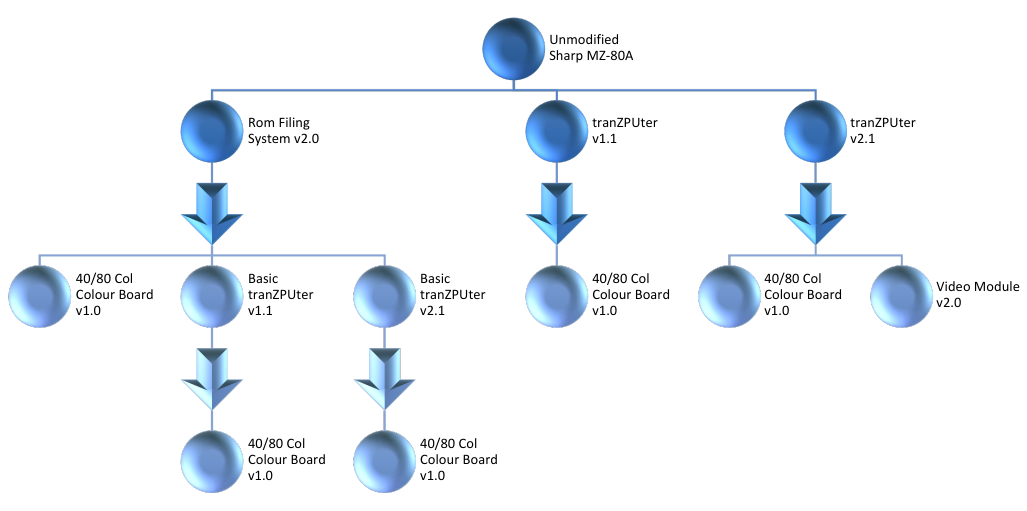 Sharp MZ-80A Upgrades
Sharp MZ-80A Upgrades
The Sharp MZ-80A, a venerable piece of computing history, slow in comparison with modern computers but still worthy of its place in the books of computing history.
Although aimed at the consumer market as a personal computer, it's all in design, excellent tactile keyboard and screen, a range of peripherals such as floppy disk drives and printers, squarely placed it into the business and training sector. Sharp somewhat intentionally knobbled it by restricting the display to 40 characters wide and limiting the memory to 48K so that it would not compete with it's business machine, the MZ80B, but apart from these limitations, it was a business machine in sheeps clothing. External vendors soon provided add-ons to correct these limitations but they never really caught on, either cost, physical changes to the machine invalidating the warranty or just lack of advertising meant not many machines were upgraded.
It is not easy to know how many still exist but if e-bay is a good indicator, there are still quite a few around and judging from the websites and active forums, still a machine of interest and in active use.
This section of my projects portfolio is dedicated to upgrades I've designed and made for the Sharp MZ-80A. They correct the original limitations and add additional features and horsepower such as a 20MHz Z80 with 512K RAM, bit-mapped graphics, 64K CP/M and BASIC etc. The upgrades come as both hardware and software, the software (such as CP/M) requires the hardware upgrade in order to operate (exceptions, Microsoft BASIC), so I'll only concentrate on the hardware details in the following paragraphs.
The projects werent developed for commercial purposes, more a learning and refresher course of my past skills and with being an original owner of this machine, to make the upgrades I always wanted at the time!
All the projects follow a simple rule, 'No permanent physical changes' - from my perspective, antiques shouldnt be destroyed and any changes should be reversible to restore the machine to original factory state. In saying that, enhancements to make the computer more useable are always welcome, hence these projects, enhancements without consequence.
The following diagram outlines the upgrade path available for the Sharp MZ80A.
Although aimed at the consumer market as a personal computer, it's all in design, excellent tactile keyboard and screen, a range of peripherals such as floppy disk drives and printers, squarely placed it into the business and training sector. Sharp somewhat intentionally knobbled it by restricting the display to 40 characters wide and limiting the memory to 48K so that it would not compete with it's business machine, the MZ80B, but apart from these limitations, it was a business machine in sheeps clothing. External vendors soon provided add-ons to correct these limitations but they never really caught on, either cost, physical changes to the machine invalidating the warranty or just lack of advertising meant not many machines were upgraded.
It is not easy to know how many still exist but if e-bay is a good indicator, there are still quite a few around and judging from the websites and active forums, still a machine of interest and in active use.
This section of my projects portfolio is dedicated to upgrades I've designed and made for the Sharp MZ-80A. They correct the original limitations and add additional features and horsepower such as a 20MHz Z80 with 512K RAM, bit-mapped graphics, 64K CP/M and BASIC etc. The upgrades come as both hardware and software, the software (such as CP/M) requires the hardware upgrade in order to operate (exceptions, Microsoft BASIC), so I'll only concentrate on the hardware details in the following paragraphs.
The projects werent developed for commercial purposes, more a learning and refresher course of my past skills and with being an original owner of this machine, to make the upgrades I always wanted at the time!
All the projects follow a simple rule, 'No permanent physical changes' - from my perspective, antiques shouldnt be destroyed and any changes should be reversible to restore the machine to original factory state. In saying that, enhancements to make the computer more useable are always welcome, hence these projects, enhancements without consequence.
The following diagram outlines the upgrade path available for the Sharp MZ80A.

I followed two paths in the upgrades, one to use original discrete logic, albeit for space limitations I opted to use SMD technology rather than the original plated through DIL and the other
using more advanced technologies in the form of CPLD (complex logic devices - thousands of gates in a single IC programmed per design requirements) and FPGA's (field programmable gate arrays,
similar to CPLDs but much more programmable resources and features). I also opted to use an ARM Cortex-M4, one of ARM's more recent embedded processors, as an optional I/O processor. The I/O
processor is not really required in the discrete logic versions but can add additional features.
The projects use a good mix of new and old hardware technologies and a good mix of software technologies such as Assembler (Z80, ARM), C/C++ and VHDL programming languages.
If your interested in these projects you may be interested in the Sharp for vintage reasons and therefore keeping the machine on it's original design paths, in which case you would choose the discrete logic upgrades, otherwise the CPLD/FPGA versions use less space, a few more features and future expandability.
Please see the relevant section in the index on the left for board details and the above map on which boards can be combined together, the arrow indicates an optional addition. ie. Rom Disk Board v2.0 + 40/80 Col Colour Board v1.0 allows for program storage in ROM and SD Card, 512K paged RAM and ability to run CP/M.
The projects use a good mix of new and old hardware technologies and a good mix of software technologies such as Assembler (Z80, ARM), C/C++ and VHDL programming languages.
If your interested in these projects you may be interested in the Sharp for vintage reasons and therefore keeping the machine on it's original design paths, in which case you would choose the discrete logic upgrades, otherwise the CPLD/FPGA versions use less space, a few more features and future expandability.
Please see the relevant section in the index on the left for board details and the above map on which boards can be combined together, the arrow indicates an optional addition. ie. Rom Disk Board v2.0 + 40/80 Col Colour Board v1.0 allows for program storage in ROM and SD Card, 512K paged RAM and ability to run CP/M.
Credits
Where I have used or based any component on a 3rd parties design I have included the original authors copyright notice within the headers or given due credit. All 3rd party software, to my knowledge and research, is open source and freely useable, if there is found to be any component with licensing restrictions, it will be removed from this repository and a suitable link/config provided.
Licenses
This design, hardware and software, is licensed under the GNU Public Licence v3.
The Gnu Public License v3
The source and binary files in this project marked as GPL v3 are free software: you can redistribute it and-or modify it under the terms of the GNU General Public License as published by the Free Software Foundation, either version 3 of the License, or (at your option) any later version.
The source files are distributed in the hope that it will be useful, but WITHOUT ANY WARRANTY; without even the implied warranty of MERCHANTABILITY or FITNESS FOR A PARTICULAR PURPOSE. See the GNU General Public License for more details.
You should have received a copy of the GNU General Public License along with this program. If not, see http://www.gnu.org/licenses/.
The source files are distributed in the hope that it will be useful, but WITHOUT ANY WARRANTY; without even the implied warranty of MERCHANTABILITY or FITNESS FOR A PARTICULAR PURPOSE. See the GNU General Public License for more details.
You should have received a copy of the GNU General Public License along with this program. If not, see http://www.gnu.org/licenses/.